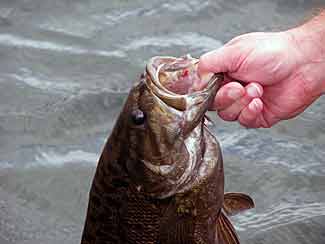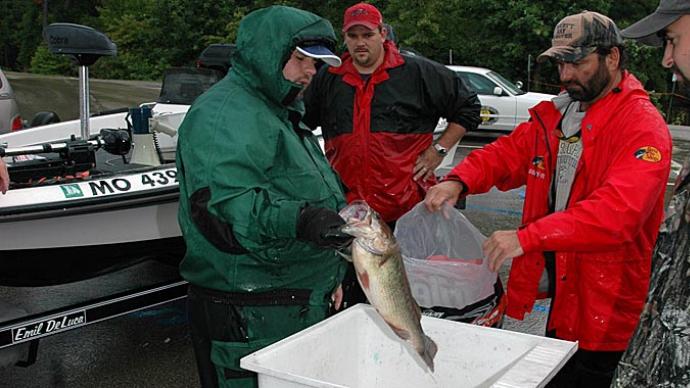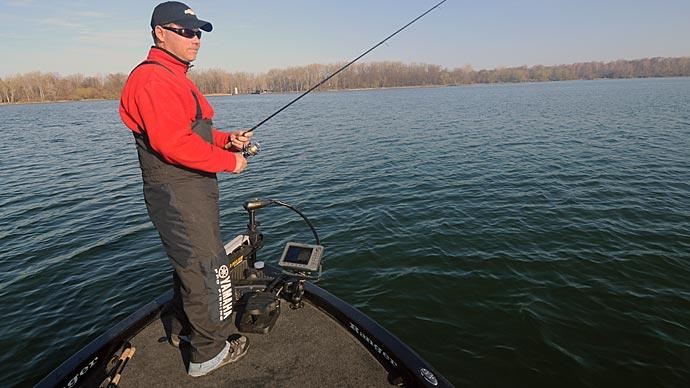
When we think of fish and how they relate to their environment, we should realize they use sensory capabilities common to most animals, including man. While the sense of feeling is present, a creature is often too close to a predator to survive in nature before this is of any value. However, fish rely on vision, odor detection (smell), and hearing (detection of movement) for survival in their environment. If they are good at adapting these skills, they don't get eaten when they are small and get to be mature and larger fish.
We enhance the visual appeal of lures by using a wide array of colors. There also has been the addition of sound chambers to increase the noise that baits give off as they come through the water.
In recent vintage, the focus has been increasingly placed on developing additives that enhance lures' odor appeal. The debate about the negative influence of odor on bass was first introduced into my fishing world when a couple of old timers allowed me to tag along on a crappie/bass trip. The explanation of why some folks could catch fish and others couldn't in the same boat was explained as a harmful odor one guy was putting on the minnow when he handled them. I had realized early on that catfish were very sensitive to odors as a stimulus for feeding, but bass or crappie? After all, a minnow was a minnow.
Then came my formative years as I learned about lures and the use of artificial bait in general. A couple of articles appeared in some national outdoor magazines (on which I placed more emphasis than some English assignments in high school), which listed the whole range of things you could get on your hands and thus add a repellant factor to the lure as sensed by the bass. These included gasoline, oil, battery acid (I never figured out who tested this one with their hand), bug spray, and other associated petrochemical products.
At this point, several things happened in my fishing career that saved me from spending long hours worrying about the impact of odors on lures. The first was that I predominately began to fish crankbaits, and the style I used for presentation didn't permit much time for a bass to smell a bait while it passed through the strike zone. The second was learning about the test of odors on crankbait efficiency in Floyd Mabry's boat. Floyd was a person I enjoyed knowing. His design of crankbaits and the ability to use them are legendary, resulting in his entry into the Texas Fishing Hall of Fame. However, you need to appreciate further that while he proved that cranks weren't just for trolling, most other bass fishermen in the late 1960s were committed worm fishing enthusiasts.
| ...some chemicals emitted from ground-up crayfish, shiners, shad etc., are repulsive to bass. |
The story goes that Floyd was in a school of summertime bass, and his young fishing partner would spend time after each cast greasing up his crankbait with some secret recipe. As a result, Floyd was catching fish on practically every cast. Still, the young guy made a terrible mistake of lecturing the old pro about the importance of using an odor masker in keeping with what he had read in a recent hunting/fishing magazine. That did it, according to a buddy in an adjacent boat. Floyd quietly removed the lid on his gas tank, slipped the crankbait' into the gas, and continued catching bass.
I wouldn't recommend this as an additive, but it must mask any human odor. It also conveyed that the human scent and even a strong odor such as gasoline were not as crucial on faster-fished baits as we have begun to appreciate with slow-moving ones.
The use of odor attractants, feeding stimuli, or whatever you call them, has been primarily focused on jigs, worms, and other soft plastics that are fished slowly. However, the emphasis on additives to soft plastics was taken to a new height when companies began to develop spray-on products or enhancers incorporated into the product.
The Berkley folks went further than grinding up natural foods and making a solution out of their extracts. For several years Dr. Keith Jones, Director of Fish Research at Berkley, has led a team whose focus has been creating the basis of Power Baits through odor stimuli.
In essence, they have extracted the chemicals from significant food sources and worked to determine the most effective for stimulating bass. Dr. Jones noted that some chemicals emitted from ground-up crayfish, shiners, shad, etc., are repulsive to bass. These are particularly concentrated in some specific organs. Of course, a bass doesn't have a choice when he eats the whole critter, but the logic of the research at Berkley and other companies is to give the bass more of the "good stuff" and eliminate foul odors or flavors.
| The older a bass becomes, the larger it's olfactory lobe; thus, its odor-detection capability increases. |
The formulas are constantly being improved to the level that he indicated the present tournament grade strength that is offered had produced a 50% increase in angler success when compared to the effectiveness of the original Power Baits formula on the same lure.
As a fishing biologist, Dr. Jones emphasized the importance of the three senses that orientate a bass to its environment. First, in most circumstances, the final attack by a bass is based on vision. Second, smell, or odor, is used not only to detect potential food but also the quality of the food. In other words, there are standard features as far as smells from minnows, crawfish, and shad and unique scents emitted from each, which can be used to distinguish the species. Third, the bass picks up the vibration and alerts it that something is in the neighborhood. Finally, the eyes, "ears," and "nose" on a bass act in concert to define if the thing in its environment is food or a predator.
According to Dr. Jones, a benefit of artificial scents is that you can reduce the negative factors and increase the positive stimulation by their presence on a lure.
Since the most significant impact of odor stimuli on baits is on slow-moving baits, I also wanted to get my friend Roy Greer's input. Roy, as you may recall from a Texas Pro article I wrote, is a fishery's biologist by training who left the fisheries management area and began the Weedless Lure Company, now headquartered at Lake Fork. Roy markets a product called jig Juice as a spray-on additive for lures. His main products are jigs, spoons, and a tail spinner lure (Tail Kicker). He believes in spraying an additive on all three lures. Remember, all three are usually fished as slow-moving baits kept in the strike zone for extended periods, thus allowing the fish greater time to "smell" the bait.
Roy believes any additive serves to mask human and other odors and give off a food appeal.
The significant advantage from his perspective is that fish hold a bait longer, thus enhancing fishermen's ability to detect strikes. This is not a trivial issue since he is convinced that most folks get five times more strikes than they feel.
His other argument for the importance of odor is that the older a bass becomes, the larger its olfactory lobe, and thus its odor detection capability increases. Temper this further with the fact that older bass have a greater wealth of experience distinguishing good and bad odors you get the message that he strongly believes in odor enhancers.
Bob Murray of Professional Sporting Goods in New Braunfels also discussed his new entry into the market called Bait React. According to Murray, this product, somewhat like the Berkley strategy, was the result of work done on the chemical odor emitted from crayfish. Again the same theme was presented in that an attempt was made to emphasize the "appeal" sent out as the slick from the product spread from the lure.
The message from all those who have developed these products is the same whether using odor enhancers or feeding stimuli. It is essential for slow-moving baits.
Having tried several of the products on the same lure with and without them, I can assure you that they effectively increase the number of strikes on slow-moving baits.
If it works for the pros, then the additional time the bass holds on to a slow-moving lure with these additives certainly can help individuals who may not have as keen a sense of feel to detect more fish.




